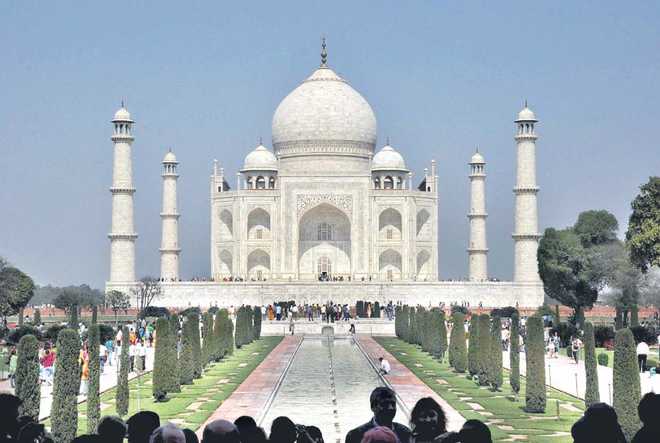The Supreme Court made a strong observation in 2000, dismissing the claim that the Taj was a Hindu temple
Archaeological Survey of India’s (ASI) decision to keep mum on the controversy triggered by a BJP functionary who has petitioned in the Allahabad High Court seeking directives to the ASI to open 20 rooms inside the Taj Mahal to check for the possible presence of Hindu idols is raising eyebrows, a report in The Tribune, Chandigarh, says.
The petition, filed by Rajneesh Singh, BJP media in-charge of Uttar Pradesh’s Ayodhya district, is yet to come up for hearing.
“Around 20 rooms in the Taj Mahal are locked and no one is allowed to enter. It is believed that in these rooms, there are idols of Hindu gods and scriptures,” the petition said.
The petitioner has also sought directives to the state government to constitute a committee to examine the 20 rooms.
“The matter is in the court and we will not like to say anything at the moment,” an ASI spokesperson said.
“The claim about the Taj is absurd. The petition should not have been allowed,” R Nandakumar, noted art historian and former fellow of Nehru Memorial Museum and Library, said. “The ASI’s stand to keep quiet on the issue amuses me,” Nandakumar added.
“Around 20 rooms in the Taj Mahal are locked and no one is allowed to enter. It is believed that in these rooms, there are idols of Hindu gods and scriptures,” the petition said.
Historian S Irfan Habib said: “The ASI is part of the government. Everyone knows what the present government at the Centre thinks on issues such as the one that has come up before the Allahabad High Court”.
Claims that the Taj Mahal is a Hindu temple have surfaced periodically, either from a lone Hindu radical or members of Hindu right-wing groups, ever since PN Oak, a writer with the pretensions to being a history enthusiast, published his 1989 book ‘Taj Mahal, the True Story: The Tale of a Temple Vandalised’,
He claimed it was built before the Islamic rule was established in India. Oak, who died in 2007, took his claim as far as the Supreme Court in 2000, where it was thrown out as no more than a “bee in his bonnet”.
A short history of the Taj Mahal chronicled in ASI’s Agra Circle website describes the monument as “built by the Mughal emperor Shah Jahan, grandson of Akbar the Great, in memory of his queen Arjumand Bano Begum, also known as ‘Mumtaz Mahal’”.
****************************************************************
Readers
These are extraordinary times. All of us have to rely on high-impact, trustworthy journalism. And this is especially true of the Indian Diaspora. Members of the Indian community overseas cannot be fed with inaccurate news.
Pravasi Samwad is a venture that has no shareholders. It is the result of an impassioned initiative of a handful of Indian journalists spread around the world. We have taken the small step forward with the pledge to provide news with accuracy, free from political and commercial influence. Our aim is to keep you, our readers, informed about developments at ‘home’ and across the world that affect you.
Please help us to keep our journalism independent and free.
In these difficult times, to run a news website requires finances. While every contribution, big or small, will makes a difference, we request our readers to put us in touch with advertisers worldwide. It will be a great help.
For more information: pravasisamwad00@gmail.com



